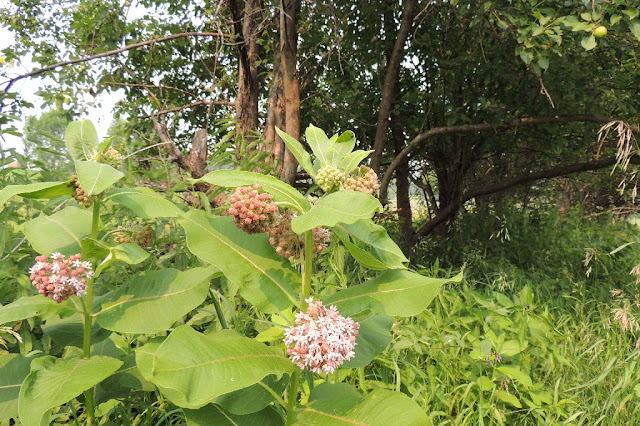At the beginning of July, an inventory of the flowering plants here on the home 40. Flowers are flowers, whether from weeds, gardens or flower beds for the bees and hummingbirds, so I mixed in a few tame ones with the wild flowers.
 |
| Margo hoes some geranium plants. These plants were brought in last fall, wintered and then set out this spring. Slowly getting going. Margo is starting to wean herself from the collar. The old pain from her back is gone, but the neck pain left over from surgery comes back after some activity. Three months from surgery and 9 months to go to complete the healing. |
 |
| Mullein plant has such nice soft velvety leaves, you wouldn't realize it contains a strong numbing pain killer. Native Americans picked the leave green like this, pounded them in the creek upstream from a fish pool and this paralyzed the fish to float them up for a few minutes to be easily caught. |
 |
| Squash are blooming in the garden |
 |
| Milkweed. Have thousands on the farm, and a few monarchs, but haven't spotted a caterpillar yet |
 |
| Red Clover is a favorite of the doe and two fawns that live in the tall grass and brush between the fields on the 40 acres |
 |
| Wild Daisies are here and there and in the ditches |
 |
| Wild Parsnip are very much a skin irritant that can last for years. Not good to mix with, although the bees and bugs like them. |
 |
| Squash have started to set already. Hope the deer don't decide to munch on them. |
 |
| Dill in the garden comes up volunteer from seed each year. This time it is in the strawberry bed |
 |
| Sumac are blooming in the ravine where the creek has almost stopped running -- just after rains now. |
 |
| More Clover -- could be Alsack clover |
 |
| Planter with some kind of climbing tame yellow flower seems to have taken off with the pansies. |
 |
| The grasses are blooming, a difficult time for those with hayfever. I used to have it, but sometime a few years back it seemed to disappear. |
 |
| Grasses are visited by pollen seekers too. |
 |
| The yellow flower with the small toothed leaves grows in the old cow pasture along with the other wild plants. I think these are called potentilla or cinquefoil. They have a shiny flower, not very large, but quite pretty |
 |
| This moth on the milkweed bloom is probably the ctenucha virginia (I had to look for moth with orange head and blue neck to find that name). The caterpillar of this looks quite like what the Fuller Brush salesman might have brought on his monthly sales trip to the farm. |
 |
| This photo from the Internet -- I think I have seen these around in fall along with the wooly bears |
 |
| Unknown small flower. Below is an enlargement of a cluster |
 |
| White clover variation |
 |
| A colony of aphids on the top of a weed. They are insects which suck plant juices/sap and then excrete a sweet 'honeydew'. Ants "raise" them for the honeydew. So we have ant farmers subletting some of our weeds to grow aphids. I charge no rent as long as they stay on the weeds and out of the garden. |
 |
I need to study up on the types of grasses that grow in the midwest. Margo took horticulture in college -- 2 year course and had a good identification book, except it was black and white photos. I need a color one. The problem is, there is a book for grasses in the midwest but it has 700 color pictures which makes me think I might never figure them out!
Grass Identification for the Midwest |
 |
| A ground cherry in the orchard -- pygmy groundcherry I think. They grow wild in my sand garden and in the old sandy fields. They have an edible berry that actually tastes OK, similar to the tame groundcherry. |
 |
| Fleabane comes in shades from white to purple and is a rather pretty tiny flower that stands tall. |
 |
| A yarrow I think they range from white to yellow here. |
 |
Yarrow are interesting if you move close.  |

 |
| Swamp milkweed soon to bloom |
 |
| More of the wild parsnip |
 |
Hairy vetch has claimed a spot on the hillside
It climbs over the rest of the grass and weeds to get sunlight and attract bees. The seeds are in pods, tiny round black bb's. A legume, it produces its own nitrogen and grows lushly on the sand barrens too. |
 |
| Thistles must have lots of pollen and nectar as the honey bees seem to prefer them. |
 |
| Seed heads forming on the wild parsnips. |















































































